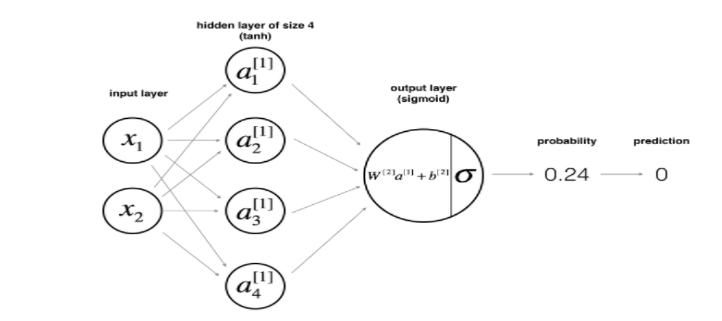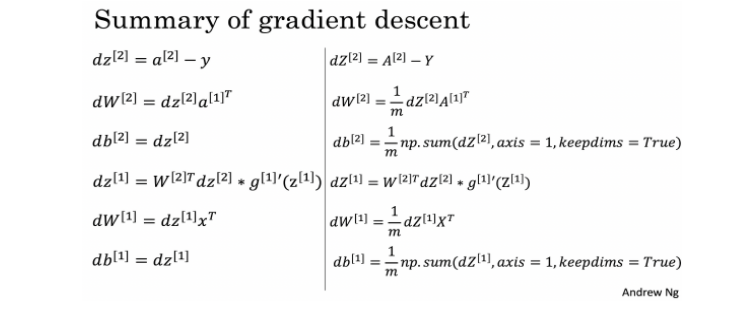建立一个隐藏层的神经网络模型
1、本次搭建的神经网络模型具有一个隐藏层的二分类
2、需要的激活函数有tanh,sigmoid
3、用了正向传播和反向传播。
4、计算交叉熵损失。
模型如下:

用到的数学公式:

建立神经网络的一般方法是:
1、定义神经网络结构(比如输入单元、隐藏单元等等)
2、初始化模型的参数
3、循环(迭代次数):
⑴实现向前传播
⑵计算损失
⑶实现向后传播以获得渐变
⑷更新参数(梯度下降)
1、定义神经网络结构
本次设置隐藏层大小为4
n_x:输入层的大小。
n_h:隐藏层的大小(将其设置为4)
n_y:输出层的大小。

1 def layer_sizes(X, Y): 2 """ 3 Arguments: 4 X -- input dataset of shape (input size, number of examples) 5 Y -- labels of shape (output size, number of examples) 6 7 Returns: 8 n_x -- the size of the input layer 9 n_h -- the size of the hidden layer 10 n_y -- the size of the output layer 11 """ 12 ### START CODE HERE ### (≈ 3 lines of code) 13 n_x = X.shape[0] # size of input layer 14 n_h = 4 15 n_y = Y.shape[0] # size of output layer 16 ### END CODE HERE ### 17 return (n_x, n_h, n_y)
2、初始化模型的参数
使用随机值初始化权重矩阵、将偏差向量初始化为零。

1 def initialize_parameters(n_x, n_h, n_y): 2 """ 3 Argument: 4 n_x -- size of the input layer 5 n_h -- size of the hidden layer 6 n_y -- size of the output layer 7 8 Returns: 9 params -- python dictionary containing your parameters: 10 W1 -- weight matrix of shape (n_h, n_x) 11 b1 -- bias vector of shape (n_h, 1) 12 W2 -- weight matrix of shape (n_y, n_h) 13 b2 -- bias vector of shape (n_y, 1) 14 """ 15 16 np.random.seed(2) # we set up a seed so that your output matches ours although the initialization is random. 17 18 ### START CODE HERE ### (≈ 4 lines of code) 19 W1 = np.random.randn(n_h, n_x) * 0.01 20 b1 = np.zeros((n_h, 1)) 21 W2 = np.random.randn(n_y, n_h) * 0.01 22 b2 = np.zeros((n_y, 1)) 23 ### END CODE HERE ### 24 25 assert (W1.shape == (n_h, n_x)) 26 assert (b1.shape == (n_h, 1)) 27 assert (W2.shape == (n_y, n_h)) 28 assert (b2.shape == (n_y, 1)) 29 30 parameters = {"W1": W1, 31 "b1": b1, 32 "W2": W2, 33 "b2": b2} 34 35 return parameters
3、循环
⑴向前传播:
向前传播需要计算Z1、A1、Z2、A2,将计算得到的值存储在缓存里,方便反向传播的计算
激活函数用tanh和sigmoid。

1 def forward_propagation(X, parameters): 2 """ 3 Argument: 4 X -- input data of size (n_x, m) 5 parameters -- python dictionary containing your parameters (output of initialization function) 6 7 Returns: 8 A2 -- The sigmoid output of the second activation 9 cache -- a dictionary containing "Z1", "A1", "Z2" and "A2" 10 """ 11 # Retrieve each parameter from the dictionary "parameters" 12 ### START CODE HERE ### (≈ 4 lines of code) 13 W1 = parameters['W1'] 14 b1 = parameters['b1'] 15 W2 = parameters['W2'] 16 b2 = parameters['b2'] 17 ### END CODE HERE ### 18 19 # Implement Forward Propagation to calculate A2 (probabilities) 20 ### START CODE HERE ### (≈ 4 lines of code) 21 Z1 = np.dot(W1,X)+b1 22 #A1 = sigmoid(Z1) 23 A1 = np.tanh(Z1) 24 Z2 = np.dot(W2,A1)+b2 25 #A2 = sigmoid(Z2) 26 A2 = sigmoid(Z2) 27 ### END CODE HERE ### 28 29 assert(A2.shape == (1, X.shape[1])) 30 31 cache = {"Z1": Z1, 32 "A1": A1, 33 "Z2": Z2, 34 "A2": A2} 35 36 return A2, cache
⑵计算代价成本 J
J的计算如下:

1 def compute_cost(A2, Y, parameters): 2 """ 3 Computes the cross-entropy cost given in equation (13) 4 5 Arguments: 6 A2 -- The sigmoid output of the second activation, of shape (1, number of examples) 7 Y -- "true" labels vector of shape (1, number of examples) 8 parameters -- python dictionary containing your parameters W1, b1, W2 and b2 9 10 Returns: 11 cost -- cross-entropy cost given equation (13) 12 """ 13 14 m = Y.shape[1] # number of example 15 16 # Compute the cross-entropy cost 17 ### START CODE HERE ### (≈ 2 lines of code) 18 logprobs = np.multiply(np.log(A2),Y)+np.multiply((1-Y),np.log(1-A2)) 19 cost = -1/m*np.sum(logprobs) 20 ### END CODE HERE ### 21 22 cost = np.squeeze(cost) # makes sure cost is the dimension we expect. 23 # E.g., turns [[17]] into 17 24 assert(isinstance(cost, float)) 25 26 return cost
⑶反向传播
用到的公式:

计算dZ1时需要用到g[1]'(Z[1]),由于激活函数是tanh,g(z)' = 1 − (g(z))2 ,即 g[1]'(Z[1]) = 1 - (g[1](Z[1]))2 。
当然,如果激活函数是sigmoid时,就是g(z)' = g(z)(1 − g(z))。

1 def backward_propagation(parameters, cache, X, Y): 2 """ 3 Implement the backward propagation using the instructions above. 4 5 Arguments: 6 parameters -- python dictionary containing our parameters 7 cache -- a dictionary containing "Z1", "A1", "Z2" and "A2". 8 X -- input data of shape (2, number of examples) 9 Y -- "true" labels vector of shape (1, number of examples) 10 11 Returns: 12 grads -- python dictionary containing your gradients with respect to different parameters 13 """ 14 m = X.shape[1] 15 16 # First, retrieve W1 and W2 from the dictionary "parameters". 17 ### START CODE HERE ### (≈ 2 lines of code) 18 W1 = parameters['W1'] 19 W2 = parameters['W2'] 20 ### END CODE HERE ### 21 22 # Retrieve also A1 and A2 from dictionary "cache". 23 ### START CODE HERE ### (≈ 2 lines of code) 24 A1 = cache['A1'] 25 A2 = cache['A2'] 26 ### END CODE HERE ### 27 28 # Backward propagation: calculate dW1, db1, dW2, db2. 29 ### START CODE HERE ### (≈ 6 lines of code, corresponding to 6 equations on slide above) 30 dZ2 = A2-Y 31 dW2 = 1/m*np.dot(dZ2,A1.T) 32 db2 = 1/m*np.sum(dZ2,axis=1,keepdims=True) 33 dZ1 = np.dot(W2.T,dZ2)*(1 - np.power(A1, 2)) 34 dW1 = 1/m*np.dot(dZ1,X.T) 35 db1 = 1/m*np.sum(dZ1,axis=1,keepdims=True) 36 ### END CODE HERE ### 37 38 grads = {"dW1": dW1, 39 "db1": db1, 40 "dW2": dW2, 41 "db2": db2} 42 43 return grads
⑷更新参数
通过 更新参数。
更新参数。

1 def update_parameters(parameters, grads, learning_rate = 1.2): 2 """ 3 Updates parameters using the gradient descent update rule given above 4 5 Arguments: 6 parameters -- python dictionary containing your parameters 7 grads -- python dictionary containing your gradients 8 9 Returns: 10 parameters -- python dictionary containing your updated parameters 11 """ 12 # Retrieve each parameter from the dictionary "parameters" 13 ### START CODE HERE ### (≈ 4 lines of code) 14 W1 = parameters['W1'] 15 b1 = parameters['b1'] 16 W2 = parameters['W2'] 17 b2 = parameters['b2'] 18 ### END CODE HERE ### 19 20 # Retrieve each gradient from the dictionary "grads" 21 ### START CODE HERE ### (≈ 4 lines of code) 22 dW1 = grads['dW1'] 23 db1 = grads['db1'] 24 dW2 = grads['dW2'] 25 db2 = grads['db2'] 26 ## END CODE HERE ### 27 28 # Update rule for each parameter 29 ### START CODE HERE ### (≈ 4 lines of code) 30 W1 -= learning_rate*dW1 31 b1 -= learning_rate*db1 32 W2 -= learning_rate*dW2 33 b2 -= learning_rate*db2 34 ### END CODE HERE ### 35 36 parameters = {"W1": W1, 37 "b1": b1, 38 "W2": W2, 39 "b2": b2} 40 41 return parameters
4、将之前的合并到一个函数里

1 def nn_model(X, Y, n_h, num_iterations = 10000, print_cost=False): 2 """ 3 Arguments: 4 X -- dataset of shape (2, number of examples) 5 Y -- labels of shape (1, number of examples) 6 n_h -- size of the hidden layer 7 num_iterations -- Number of iterations in gradient descent loop 8 print_cost -- if True, print the cost every 1000 iterations 9 10 Returns: 11 parameters -- parameters learnt by the model. They can then be used to predict. 12 """ 13 14 np.random.seed(3) 15 n_x = layer_sizes(X, Y)[0] 16 n_y = layer_sizes(X, Y)[2] 17 18 # Initialize parameters, then retrieve W1, b1, W2, b2. Inputs: "n_x, n_h, n_y". Outputs = "W1, b1, W2, b2, parameters". 19 ### START CODE HERE ### (≈ 5 lines of code) 20 parameters = initialize_parameters(n_x, n_h, n_y) 21 W1 = parameters['W1'] 22 b1 = parameters['b1'] 23 W2 = parameters['W2'] 24 b2 = parameters['b2'] 25 ### END CODE HERE ### 26 27 # Loop (gradient descent) 28 29 for i in range(0, num_iterations): 30 31 ### START CODE HERE ### (≈ 4 lines of code) 32 # Forward propagation. Inputs: "X, parameters". Outputs: "A2, cache". 33 A2, cache = forward_propagation(X, parameters) 34 35 # Cost function. Inputs: "A2, Y, parameters". Outputs: "cost". 36 cost = compute_cost(A2, Y, parameters) 37 38 # Backpropagation. Inputs: "parameters, cache, X, Y". Outputs: "grads". 39 grads = backward_propagation(parameters, cache, X, Y) 40 41 # Gradient descent parameter update. Inputs: "parameters, grads". Outputs: "parameters". 42 parameters = update_parameters(parameters, grads) 43 44 ### END CODE HERE ### 45 46 # Print the cost every 1000 iterations 47 if print_cost and i % 1000 == 0: 48 print ("Cost after iteration %i: %f" %(i, cost)) 49 50 return parameters
5、预测
可以写一个预测函数,用来验证得到的神经网络模型的效果怎么样。
预测使用下面规则:


1 def predict(parameters, X): 2 """ 3 Using the learned parameters, predicts a class for each example in X 4 5 Arguments: 6 parameters -- python dictionary containing your parameters 7 X -- input data of size (n_x, m) 8 9 Returns 10 predictions -- vector of predictions of our model (red: 0 / blue: 1) 11 """ 12 13 # Computes probabilities using forward propagation, and classifies to 0/1 using 0.5 as the threshold. 14 ### START CODE HERE ### (≈ 2 lines of code) 15 A2, cache = forward_propagation(X, parameters) 16 predictions = (A2 > 0.5) 17 ### END CODE HERE ### 18 19 return predictions
6、其它
由于nn_model模型已经封装好了,现在只需要传入参数就可以得到结果了。然后我们可以调参,设置不同的隐藏层大小来得到不同的效果,依次选择最佳的值。
plt.figure(figsize=(16, 32))
hidden_layer_sizes = [1, 2, 3, 4, 5, 20, 50]
for i, n_h in enumerate(hidden_layer_sizes):
plt.subplot(5, 2, i+1)
plt.title('Hidden Layer of size %d' % n_h)
parameters = nn_model(X, Y, n_h, num_iterations = 5000)
plot_decision_boundary(lambda x: predict(parameters, x.T), X, Y)
predictions = predict(parameters, X)
accuracy = float((np.dot(Y,predictions.T) + np.dot(1-Y,1-predictions.T))/float(Y.size)*100)
print ("Accuracy for {} hidden units: {} %".format(n_h, accuracy))
得到的准确率如下:
Accuracy for 1 hidden units: 67.5 % Accuracy for 2 hidden units: 67.25 % Accuracy for 3 hidden units: 90.75 % Accuracy for 4 hidden units: 90.5 % Accuracy for 5 hidden units: 91.25 % Accuracy for 20 hidden units: 90.0 % Accuracy for 50 hidden units: 90.25 %
可以看到隐藏层大小为5时效果最佳,可见不是越大越好,也不是越小越好。根据不同的问题需要选择不同的值。




